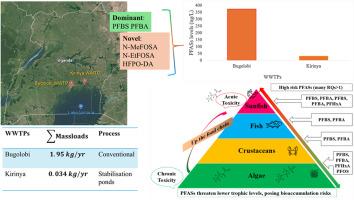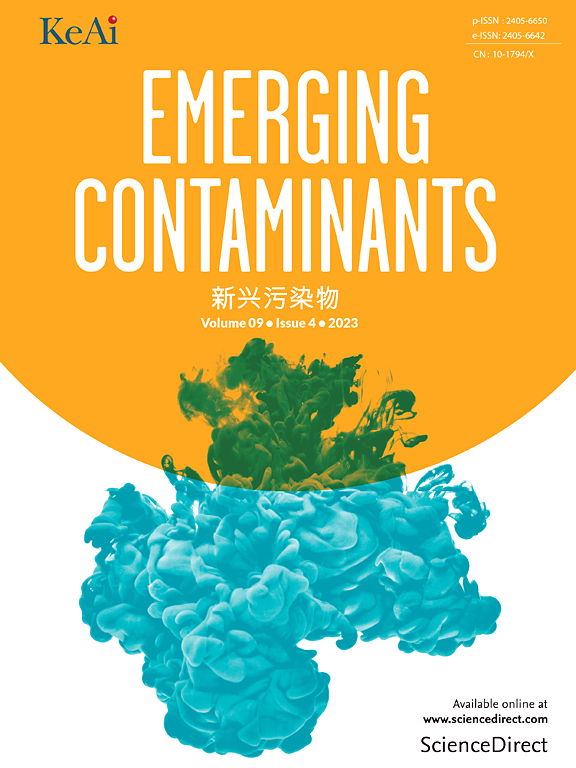Novel and legacy per- and poly-fluoroalkyl substances in major wastewater treatment plants within the Lake Victoria basin, East Africa
IF 6.9
2区 环境科学与生态学
Q1 ENVIRONMENTAL SCIENCES
引用次数: 0
Abstract
Over the past two decades, rapid urbanization and industrialization in Uganda have generated wastewater containing emerging contaminants including per- and poly-fluoroalkyl substances (PFASs). This study assessed PFASs contamination of wastewater from Bugolobi (Kampala) and Kirinya (Jinja) wastewater treatment plants (WWTPs) by analyzing 80 influent and effluent samples for 15 PFASs using LC-MS/MS. We quantified 10 PFASs, with levels ranging from non-detectable (n.d) up to 372.4 ng/L (mean: 20.94 ± 0.42 ng/L). At Bugolobi WWTP, influent levels ranged from n.d to 190.01 ng/L (60.85 ± 1.03 ng/L) while effluents varied from n.d to 372.4 ng/L (237.91 ± 7.06 ng/L). At Kirinya WWTP, influent levels ranged from n.d to 29.37 ng/L (17.58 ± 3.54 ng/L) and effluents up to 30.21 ng/L (7.79 ± 0.85 ng/L). Short-chain PFASs (PFBS, PFBA) were more predominant, suggesting their possible use or degradation of the long-chain PFASs. Total mass loadings were higher at Bugolobi WWTP (5353.56 mg/day), serving the more densely populated Kampala, than at Kirinya WWTP (93.62 mg/day). PFSAs exhibited higher removal (72.45 % Bugolobi; 36.45 % Kirinya) than PFCAs (−127.38 % Bugolobi; −20.50 % Kirinya), which could be attributed to their stronger hydrophobic adsorption and partial biodegradation. Bugolobi, with ⁓82.59 % total removal outperformed Kirinya (∼25.19 %) due to its advanced conventional treatment. Ecological risk assessment revealed higher risks at lower trophic levels at Bugolobi compared to Kirinya, likely due to lower influx and partial mitigation by its pond-based system. These findings highlight the role of WWTPs as critical point sources of PFASs, posing ecological risks to aquatic ecosystems.

东非维多利亚湖盆地内主要废水处理厂中新型和遗留的单氟烷基和多氟烷基物质
在过去二十年中,乌干达的快速城市化和工业化产生的废水中含有新出现的污染物,包括全氟烷基和多氟烷基物质。本研究通过使用LC-MS/MS分析80个进水和出水样品中15种PFASs,评估了Bugolobi(坎帕拉)和Kirinya(金贾)污水处理厂(WWTPs)废水中的PFASs污染情况。我们量化了10种PFASs,其水平范围从不可检测到372.4 ng/L(平均值:20.94±0.42 ng/L)。Bugolobi污水处理厂的进水水平为nd ~ 190.01 ng/L(60.85±1.03 ng/L),出水水平为nd ~ 372.4 ng/L(237.91±7.06 ng/L)。在Kirinya污水处理厂,进水水平从nd到29.37 ng/L(17.58±3.54 ng/L)不等,出水最高为30.21 ng/L(7.79±0.85 ng/L)。短链PFASs (PFBS、PFBA)居多,表明它们可能被长链PFASs利用或降解。Bugolobi污水处理厂的总质量负荷(5353.56 mg/d)高于Kirinya污水处理厂(93.62 mg/d),服务于人口更密集的坎帕拉。pfsa的去除率(Bugolobi为72.45%,Kirinya为36.45%)高于PFCAs (Bugolobi为- 127.38%,Kirinya为- 20.50%),这可能是由于pfsa具有较强的疏水吸附和部分生物降解能力。Bugolobi的总去除率为⁓82.59%,优于Kirinya(25.19%)。生态风险评估显示,与基里尼亚相比,布戈罗比较低营养水平的风险更高,这可能是由于流入较少以及池塘系统的部分缓解。这些发现强调了污水处理厂作为全氟磺酸的关键点源的作用,对水生生态系统构成了生态风险。
本文章由计算机程序翻译,如有差异,请以英文原文为准。
求助全文
约1分钟内获得全文
求助全文
来源期刊

Emerging Contaminants
Medicine-Public Health, Environmental and Occupational Health
CiteScore
10.00
自引率
6.70%
发文量
35
审稿时长
44 days
期刊介绍:
Emerging Contaminants is an outlet for world-leading research addressing problems associated with environmental contamination caused by emerging contaminants and their solutions. Emerging contaminants are defined as chemicals that are not currently (or have been only recently) regulated and about which there exist concerns regarding their impact on human or ecological health. Examples of emerging contaminants include disinfection by-products, pharmaceutical and personal care products, persistent organic chemicals, and mercury etc. as well as their degradation products. We encourage papers addressing science that facilitates greater understanding of the nature, extent, and impacts of the presence of emerging contaminants in the environment; technology that exploits original principles to reduce and control their environmental presence; as well as the development, implementation and efficacy of national and international policies to protect human health and the environment from emerging contaminants.
 求助内容:
求助内容: 应助结果提醒方式:
应助结果提醒方式:


